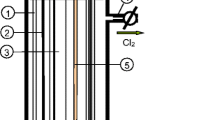Abstract
The specific conductance and its temperature dependence were measured over the entire composition range of the molten Cu2S-CuCI system. At a typical temperature of 1200°C, 10 mol pct of the ionically conducting CuCl reduced the specific conductance from about 77 ohm−1cm−1 for pure Cu2S to about 32 ohm−1cm−1, and 50 mol pct CuCl reduced the conductance to that for pure CuCl—about 5 ohm−1cm−1. The nature of electrical conduction in molten Cu2S, FeS, CuCl, and mixtures was studied by measuring the current efficiency of electrolysis at about 1100°C. The Cu2S, FeS, and mattes were found to conduct exclusively by electrons, but addition of 15 wt pct CuS to Cu2S produces a small amount of electrolysis. Addition of CuCl to Cu2S suppresses electronic conduction, and ionic conduction reaches almost 100 pct at a CuCl concentration of about 50 mol pct. These facts are interpreted in terms of electron energy level diagrams by analogy to the situation in solids.
Similar content being viewed by others
References
G. M. Pound, G. Derge, and G. Osuch: Trans. AIME (1955) 203, p. 481; Journal of Metals (March 1955).
W. Savelsberg: Ztsch. für Elektrochemie (1940) 46, p. 369.
H. Inouye, J. W. Tomlinson, and J. Chipman: Trans. Faraday Soc. (1953) 49, p. 796.
C. Wagner and E. Koch: Ztsch. für Physikalische Chemie (1936) B32, p. 439.
M. Simnad and G. Derge: Journal of Chemical Physics (1953) p. 933.
W. Truthe: Ztsch. für Anorg. Allgem. Chemie (1912) 76, p. 167.
P. Drossbach: Elektrochemie geschmolzener Salze. (1943) p. 72. Ann Arbor. Edwards Bros.
F. Seitz: Modern Theory of Solids. (1940) p. 40. New York. McGraw-Hill and Co.
G. Tamman: A Textbook of Metallography. (1925) p. 300. New York. Chemical Catalog Co.
W. Shockley: Electrons and Holes in Semiconductors. (1950) New York. D. Van Nostrand and Co.
E. Hirahara: Journal Physical Soc., Japan (1951) 6.
W. Jost: Diffusion in Solids, Liquids and Gases. (1952) p. 386. New York. Academic Press.
N. F. Mott and R. W. Gurney: Electronic Processes in Ionic Crystals. (1948) 2nd Ed. Oxford. Oxford Press.
Author information
Authors and Affiliations
Additional information
TP 4117E. Manuscript, Apr. 11, 1955. New York Meeting, February 1956.
Rights and permissions
About this article
Cite this article
Yang, L., Pound, G.M. & Derge, G. Mechanism of Electrical Conduction in Molten Cu S-Cu Cl and Mattes. JOM 8, 783–788 (1956). https://doi.org/10.1007/BF03377767
Published:
Issue Date:
DOI: https://doi.org/10.1007/BF03377767



